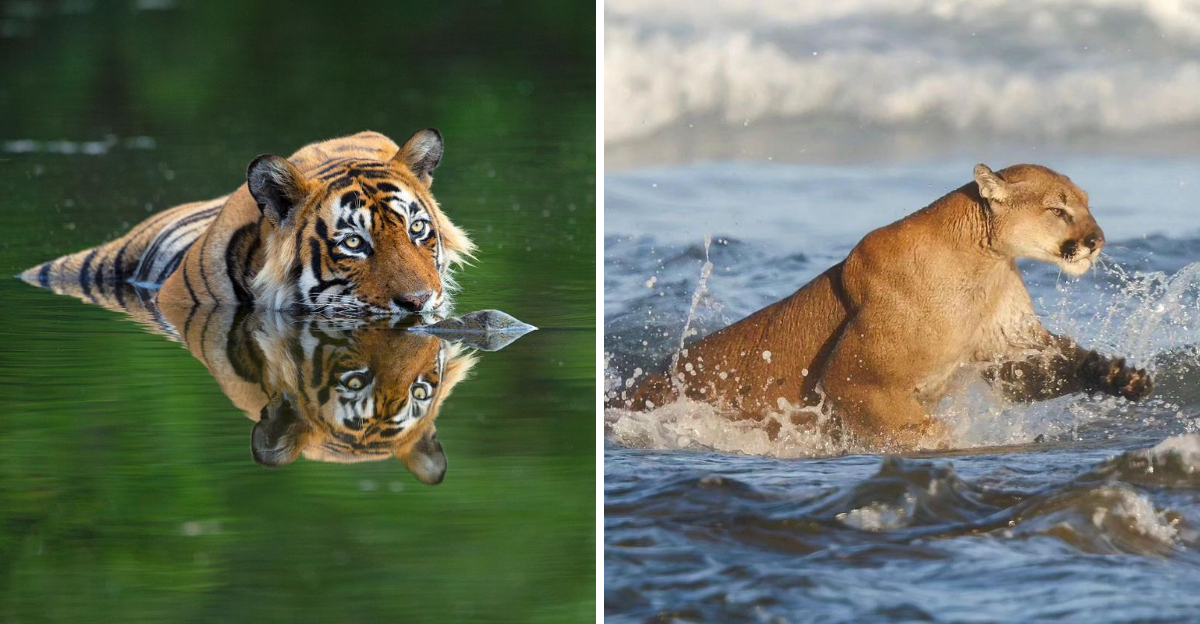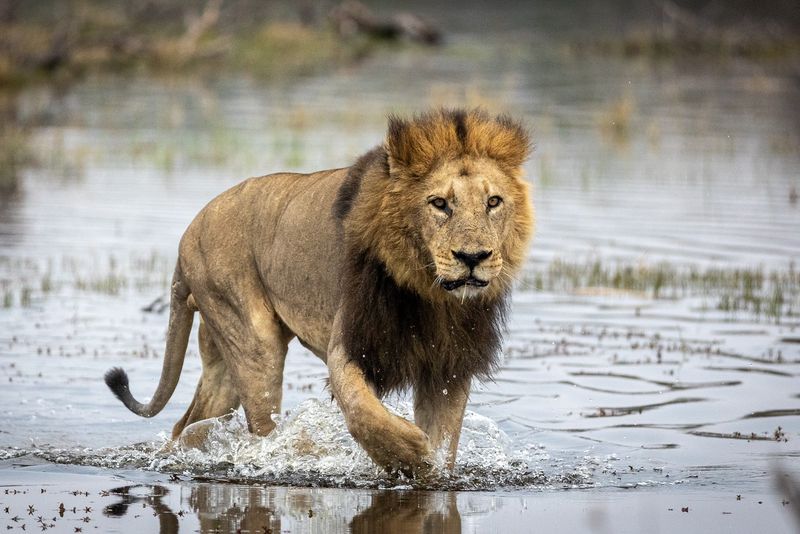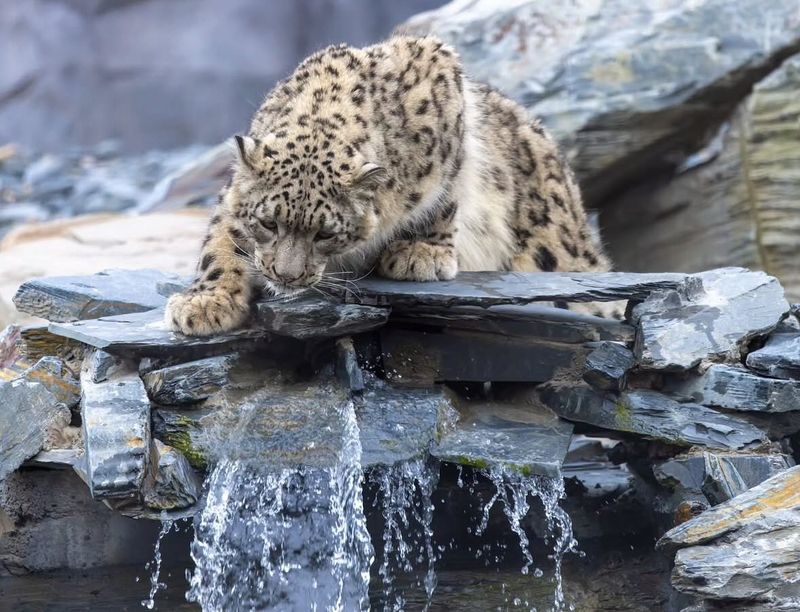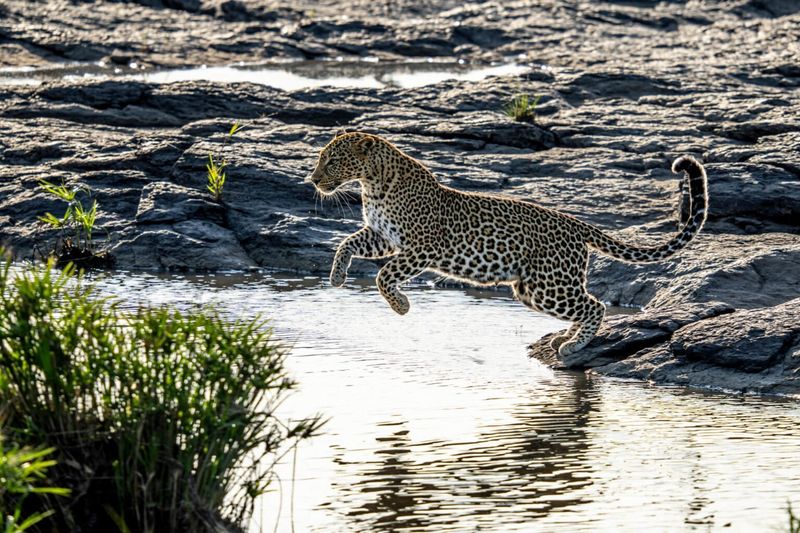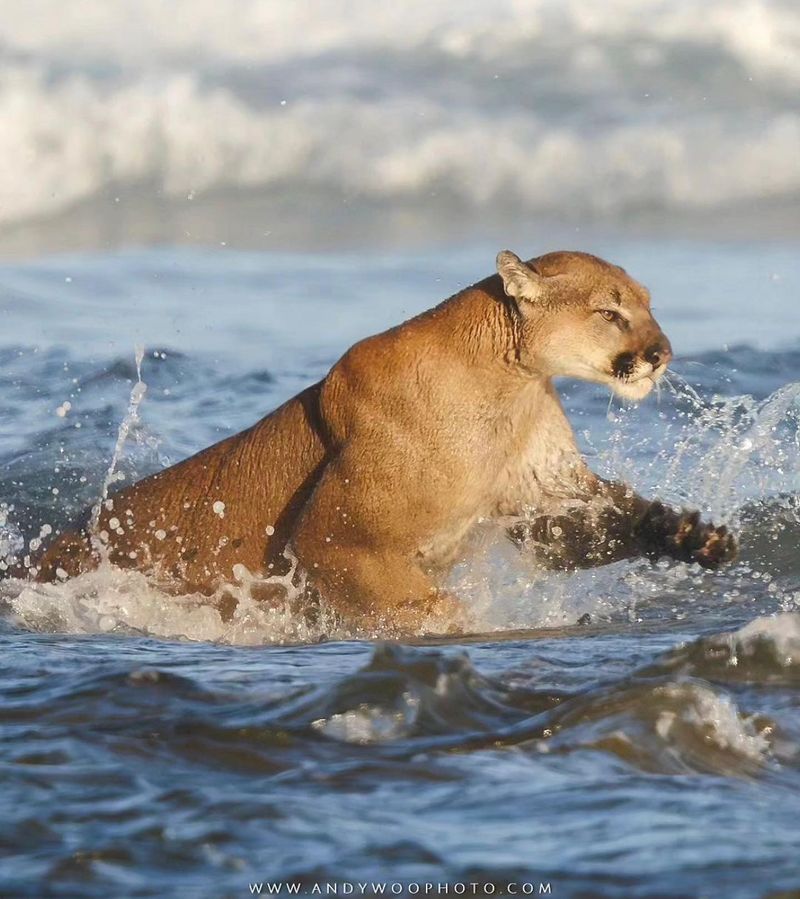📖 Table of Content:
When we picture big cats, we usually imagine them stalking prey across dry savannas or lounging in trees. Yet these magnificent predators hide an unexpected talent that few people know about – many are actually powerful swimmers!
While domestic cats typically avoid water, their larger cousins often embrace it with surprising enthusiasm and skill. Ready to have your assumptions challenged about these majestic creatures?
1. Jungle Surfers: Tigers Love The Water
Tigers don’t just tolerate water – they absolutely adore it! Unlike most felines, these striped swimmers seek out rivers and lakes, especially during scorching summer days. Their powerful muscles propel them through water with remarkable speed and grace.
A tiger can easily swim over 4 miles at a stretch, paddling with their front paws while using their long tails as rudders. This aquatic ability serves them well when hunting prey or crossing rivers to expand their territory.
In the mangrove forests of the Sundarbans, tigers have even adapted to a semi-aquatic lifestyle, regularly swimming between islands and catching fish with their sharp claws. Their webbed feet provide extra propulsion, making them truly exceptional swimmers among big cats.
2. Jaguar’s Hidden Talent: Underwater Hunters
Jaguars break all the rules about cats hating water. These spotted predators are South America’s most accomplished aquatic hunters, capable of catching caimans, capybaras, and fish directly from rivers.
What makes jaguars exceptional is their ability to swim underwater with their eyes open, tracking prey beneath the surface. With muscular bodies and strong jaws that can crush turtle shells, they fear nothing in their watery domain.
Researchers have documented jaguars swimming across wide sections of the Amazon River – a feat requiring tremendous strength against powerful currents. This swimming prowess helps them access isolated hunting territories that other predators can’t reach.
3. Lion Kings Of The Waterhole
Contrary to popular belief, lions don’t shy away from water when necessary. While not as enthusiastic as tigers, these social cats will confidently wade across rivers and swim short distances when hunting or migrating demands it. Male lions, despite their heavy manes, show surprising buoyancy in water.
In Botswana’s Okavango Delta, prides have adapted to seasonal flooding by learning to navigate through water channels. They’ve been observed swimming between islands in search of prey, sometimes traveling up to half a mile through water.
Young cubs initially show hesitation around water, but quickly learn from adults. Pride members work cooperatively in water, sometimes forming strategic positions to drive prey toward waiting swimmers, showcasing their intelligent adaptation to aquatic environments.
4. Snow Leopards: High-Altitude Swimmers
Snow leopards rarely encounter deep water in their mountainous habitats, yet these elusive cats possess remarkable swimming abilities when faced with alpine lakes or streams. Their thick fur, initially appearing as a disadvantage in water, actually provides crucial insulation against the frigid mountain waters.
Wildlife researchers have captured rare footage of these endangered cats crossing icy rivers during seasonal migrations. Their large paws, evolved for walking on snow, function effectively as paddles, while their long tails maintain perfect balance in rushing currents.
A fascinating adaptation: snow leopards can regulate their metabolism when swimming in cold water, preserving body heat more efficiently than other big cats. This allows them to traverse water obstacles in environments where temperatures regularly plunge below freezing – truly remarkable for a mountain-dwelling species.
5. Leopards Making Waves
Leopards approach water with calculated precision. These spotted athletes combine extraordinary strength with agility, enabling them to power through rivers even while carrying prey twice their weight in their jaws! Researchers in Africa have documented leopards swimming across crocodile-infested waters without hesitation.
Unlike other big cats, leopards use a unique paddling technique where they keep their bodies relatively flat and their heads completely above water. Their spotted coats provide surprising camouflage even in water, with the dappled patterns mimicking sunlight filtering through water.
Perhaps most impressive is their ability to hunt fish. In certain regions, leopards have developed specialized fishing techniques, sitting patiently on riverbanks before striking with lightning speed to catch fish with their paws – showcasing their adaptability across different environments.
6. Pumas: Mountain Swimmers With Perfect Form
Pumas (also known as mountain lions or cougars) possess swimming abilities that would impress Olympic athletes. These North American predators navigate rivers and lakes with a smooth, efficient stroke that conserves energy while covering impressive distances. Their slender, muscular bodies create minimal resistance in water.
Researchers tracking collared pumas have recorded them swimming across lakes over a mile wide without showing signs of fatigue. Their waterproof undercoat keeps them relatively dry even during extended swims, while their outer guard hairs shed water quickly once they emerge.
Most fascinating is their adaptation to different water temperatures. Pumas in northern regions can swim through partially frozen waters, while their southern cousins regularly cool off in desert waterholes during extreme heat. This versatility helps explain why pumas have the largest range of any wild land mammal in the Americas.
7. Cheetahs: Reluctant But Capable Swimmers
Cheetahs may be the least enthusiastic swimmers among big cats, but don’t be fooled – these speed demons can absolutely handle themselves in water when necessary. Their lightweight frames and long limbs, perfectly evolved for running, adapt surprisingly well to swimming motions when crossing rivers during migrations.
Unlike their bulkier cousins, cheetahs employ a rapid paddling technique that resembles their famous running stride. They keep their distinctive spotted heads well above water while their bodies remain relatively horizontal. Their semi-retractable claws provide extra grip when entering or exiting slippery riverbanks.
Conservation researchers in Botswana have documented cheetahs swimming across channels in the Okavango Delta during seasonal floods – proof that even the most specialized land predator can adapt to aquatic challenges when survival demands it. Their swimming may lack grace, but it certainly gets the job done!
